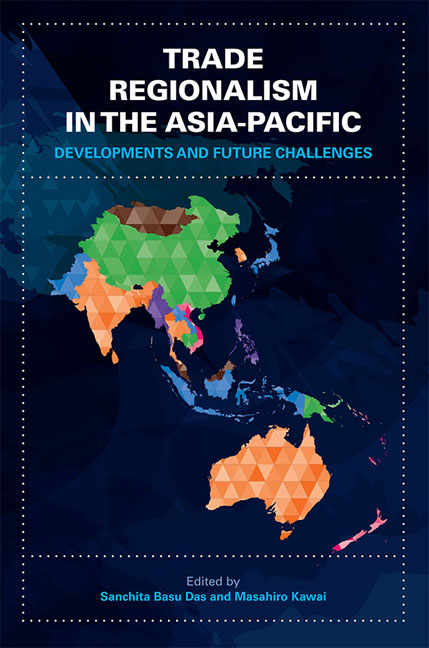Book contents
- Frontmatter
- Contents
- Foreword
- Acknowledgments
- List of Abbreviations
- The Contributors
- 1 Introductory Overview — Trade Regionalism in the Asia-Pacific: Developments and Future Challenges
- I The Trans-Pacific Partnership (TPP) Agreement
- II The Regional Comprehensive Economic Partnership (RCEP) Agreement
- 6 RCEP Prospect and Challenges: Political Economy of East Asian Integration
- 7 Challenges Facing the RCEP Negotiations
- 8 From AEC to RCEP: Implications for the CLMV
- 9 RCEP: An Indian Perspective
- III Regional Economic Integration: A Multi-stage Approach
- IV Old and Emerging Approaches to Asia-Pacific Regional Integration
- V Asia-Pacific Regional Integration: Towards Convergence?
- Index
6 - RCEP Prospect and Challenges: Political Economy of East Asian Integration
from II - The Regional Comprehensive Economic Partnership (RCEP) Agreement
Published online by Cambridge University Press: 05 July 2016
- Frontmatter
- Contents
- Foreword
- Acknowledgments
- List of Abbreviations
- The Contributors
- 1 Introductory Overview — Trade Regionalism in the Asia-Pacific: Developments and Future Challenges
- I The Trans-Pacific Partnership (TPP) Agreement
- II The Regional Comprehensive Economic Partnership (RCEP) Agreement
- 6 RCEP Prospect and Challenges: Political Economy of East Asian Integration
- 7 Challenges Facing the RCEP Negotiations
- 8 From AEC to RCEP: Implications for the CLMV
- 9 RCEP: An Indian Perspective
- III Regional Economic Integration: A Multi-stage Approach
- IV Old and Emerging Approaches to Asia-Pacific Regional Integration
- V Asia-Pacific Regional Integration: Towards Convergence?
- Index
Summary
INTRODUCTION
Over the last twenty years, regional integration initiatives have been significantly developed: not only in terms of number, which has tripled since early 1990s, but also in terms of integration topics discussed and the number of countries involved in the agreements. Significant development can be observed in East Asia and the Pacific, where countries have been actively forming trade agreements within and outside the region. Recently, the process of integration in East Asia has been conducted under the ASEAN-initiated Regional Comprehensive Economic Partnership (RCEP). At the same time, there is also another regional initiative involving some East Asian countries together with countries across the Pacific, called the Trans-Pacific Partnership (TPP) agreement which is led by the United States.
These two proposals are expected to advance the regional trade architecture through the consolidation of various existing agreements among countries in the region. Many questions, however, have been raised in the wake of these recent initiatives: What drives countries in the region to pursue greater integration? How effective are current proposals to tackle the various issues related to international trade and investment? How do those initiatives affect each other and what is the likelihood that they would be compatible with each other? What are some possible directions for these mega-integrations?
This chapter is an attempt to address these questions. It draws upon lessons from the current state of the RCEP negotiations, taking into account other initiatives in the region such as the TPP and the ASEAN Economic Community (AEC). In order to put these discussions into context, we will briefly take a look at the evolution of economic integration in the region and discuss the drivers behind its current progress. We will then talk about challenges surrounding region-wide integration, as well as some suggestions to move the process forward.
A GLANCE AT THE INTEGRATION PROCESS IN EAST ASIA AND THE PACIFIC
Formal regional integration, in the form of trade agreements, is relatively new among East Asian countries. A similar situation can also be observed, to some extent, across the Pacific Ocean. The ASEAN (Association of Southeast Asian Nations) Free Trade Area (AFTA) and North American Free Trade Agreement (NAFTA) were the only visible trade arrangements in the region in the early 1990s.
- Type
- Chapter
- Information
- Trade Regionalism in the Asia-PacificDevelopments and Future Challenges, pp. 105 - 121Publisher: ISEAS–Yusof Ishak InstitutePrint publication year: 2016



